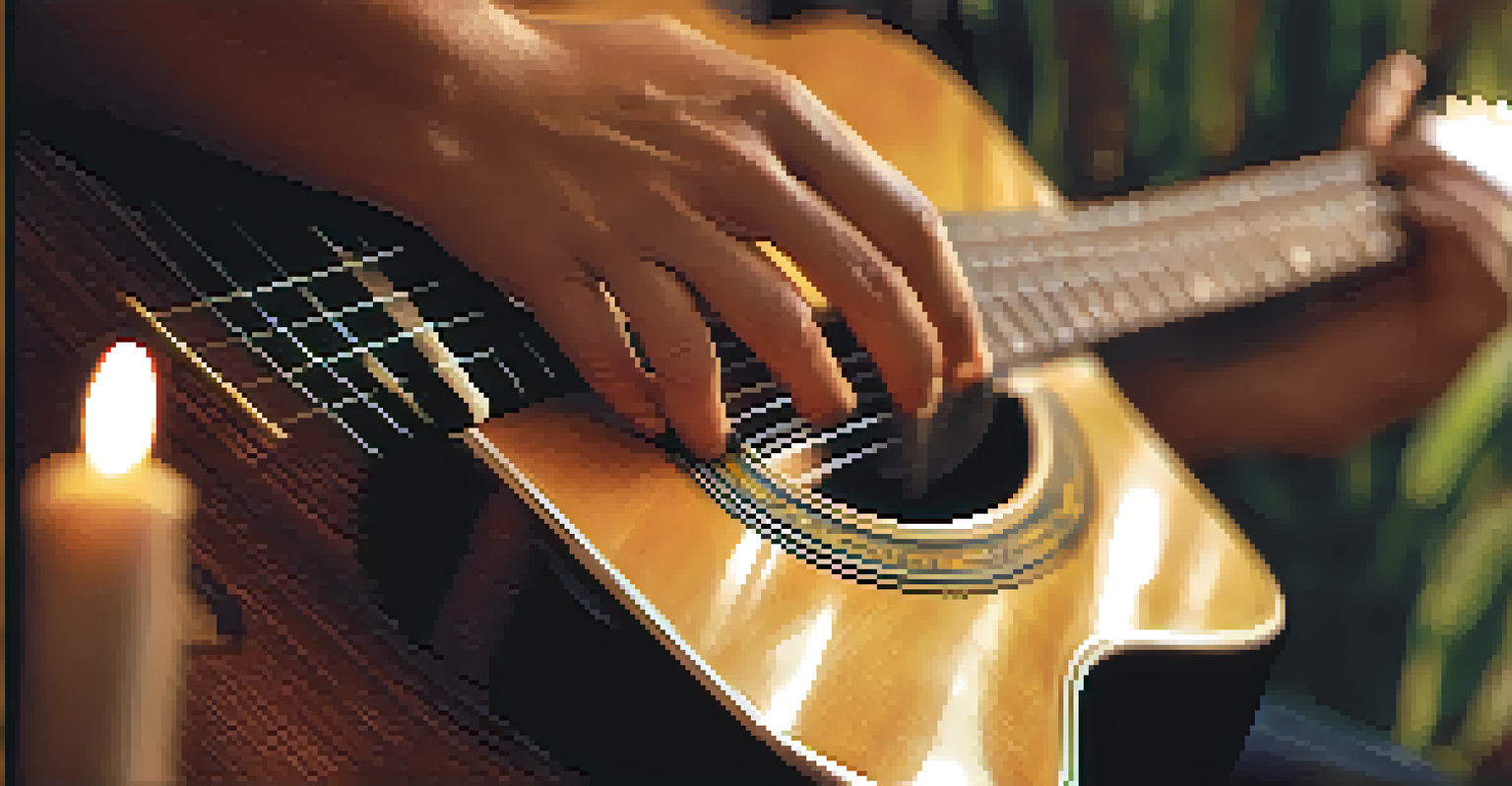Using Guitar Strumming Patterns for Effective Meditation

Understanding Meditation and Its Benefits
Meditation is a practice that encourages relaxation, focus, and awareness. It can help reduce stress, enhance concentration, and promote emotional well-being. Although often associated with silence and stillness, meditation can also flourish in more dynamic environments, such as through music.
Music can change the world because it can change people.
The combination of meditation and music creates a unique space for the mind to wander freely while maintaining a sense of rhythm and grounding. This fusion allows practitioners to experience deeper states of relaxation and connection with themselves. It often leads to greater clarity and insight during meditation.
When we incorporate elements like guitar strumming patterns, we introduce an auditory anchor that can help maintain focus. This technique can be especially beneficial for those who struggle with traditional meditation methods, offering a more engaging and rhythmic alternative.
The Role of Guitar in Meditation Practices
Guitar music has a rich history in various cultures, often used to enhance spiritual and meditative practices. The soothing sounds of strumming can create a calming atmosphere, making it easier to enter a meditative state. This is because music can influence our emotions and help shift our mental state.

When you strum a guitar, you engage both your body and mind, creating a holistic experience. The act of playing becomes a form of meditation itself, allowing you to focus on the rhythm and melody while letting go of distractions. This rhythmic engagement can help harmonize your thoughts and feelings.
Meditation Benefits of Guitar Music
Guitar music enhances meditation by creating a calming atmosphere that helps practitioners focus and relax.
Furthermore, the vibrations from the guitar resonate within us, often leading to a deeper sense of connection with ourselves and our environment. In this way, guitar playing becomes not just a musical endeavor but also a profound meditative practice.
Choosing the Right Strumming Patterns
Selecting the right strumming pattern is crucial for an effective meditation experience. Simplicity is key; choose patterns that are easy to play and allow your mind to relax. For instance, a slow down-up strumming pattern can create a calming effect, perfect for meditation.
Meditation is not about stopping thoughts, but recognizing that they are just thoughts and letting them go.
It's also important to consider the tempo of your strumming. A slower tempo can evoke tranquility, while a slightly faster rhythm might energize your meditation practice. Experimenting with different patterns can help you discover what resonates most with you personally.
Ultimately, the goal is to find a strumming pattern that you can repeat effortlessly, allowing you to focus on your breath and thoughts. This repetition fosters a meditative rhythm, helping you sink deeper into your practice.
Creating a Calm Environment for Strumming
Setting the right environment can significantly enhance your meditation experience with guitar strumming. Choose a quiet space where you feel comfortable and free from interruptions. This might be a cozy corner in your home or a peaceful outdoor setting.
Lighting candles or using soft lighting can help set a calming ambiance. Consider playing in a space where you feel connected to nature, as natural surroundings can enhance feelings of peace and mindfulness. The goal is to create a space that invites relaxation and focus.
Importance of Strumming Patterns
Choosing simple and repetitive strumming patterns is key to fostering a meditative rhythm and deepening the practice.
Incorporating elements like incense or essential oils can also elevate the atmosphere. These sensory additions can further ground you, allowing the combination of sound and smell to deepen your meditative state while you strum your guitar.
Incorporating Breathwork with Strumming
Integrating breathwork into your guitar meditation can amplify its effects. As you strum, focus on your breathing patterns—inhale as you begin a strum and exhale as you finish. This rhythmic connection between your breath and strumming can create a profound sense of harmony.
Breathwork helps ground your thoughts and brings your awareness to the present moment, enhancing the meditative experience. By coordinating your breath with the sound of the guitar, you establish a flow that can lead to deeper relaxation and mindfulness.
You might even find a natural rhythm that feels intuitive, guiding you to a state of flow. This synergy between breath and music can lead to a transcendental experience, making your meditation practice even more enriching.
Finding Your Personal Style in Guitar Meditation
As you explore guitar strumming patterns for meditation, you'll discover your unique style. Some may prefer gentle, flowing patterns, while others might enjoy more intricate, percussive strums. The key is to find what resonates with you and feels right in the moment.
Don't hesitate to experiment with different genres or styles of music. Whether it's folk, classical, or even ambient guitar sounds, each can offer a different meditative experience. Allow yourself the freedom to explore and enjoy the process of creating music.
Creating a Supportive Environment
Setting a calm and inviting space with elements like soft lighting and fragrances can significantly enhance the meditation experience.
Ultimately, your personal style will evolve as you continue to practice. Embrace this journey of self-discovery through music and meditation, allowing your guitar to be a tool for both expression and tranquility.
Tips for Consistent Practice and Growth
To reap the full benefits of using guitar strumming patterns for meditation, consistency is essential. Set aside dedicated time each day to practice, even if it’s just for a few minutes. This daily commitment can help you deepen your practice and enhance your overall experience.
Keep a meditation journal to track your thoughts and feelings during each session. This reflection can provide valuable insights and help you notice patterns in your emotional state, guiding you on your meditation journey. Over time, you'll see growth in both your guitar skills and your meditation practice.

Lastly, stay open to change. Your preferences and experiences may evolve, and that’s perfectly okay. Allow your practice to adapt, keeping it fresh and engaging while continuing to cultivate a deeper connection with your music and meditation.